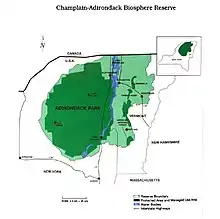Champlain-Adirondack Biosphere Reserve
The Champlain-Adirondack Biosphere Reserve is a UNESCO-designated biosphere reserve.

Summary
The Champlain-Adirondack Biosphere Reserve straddles the border of north-central New York and northwestern Vermont. Lake Champlain, the sixth largest lake in the United States, and the Adirondack and Green Mountains are the central features of the biosphere reserve. It includes extensive temperate coniferous and deciduous forests as well as large numbers of lakes, bogs, and freshwater wetlands. The primary goal of the Champlain-Adirondack Biosphere Reserve is to use education, research, and demonstration projects to encourage social and economic vitality and to preserve and improve the environmental health of the region.[1]
This temperate broadleaf forest measures 3,990,000 hectares in total. Its core area measures 960,000 hectares, its buffer zones 1,130,000 hectares, and transition areas 1,900,000 hectares. Its altitude is +29 to +1,629.[1]
It was designated as a biosphere reserve by UNESCO in 1989. The administrative authorities overseeing the Champlain-Adirondack Biosphere Reserve include Adirondack Park Agency, the U.S. Department of Agriculture, the Forest Service, and the Vermont Agency of Natural Resources.[1] The Champlain-Adirondack Biosphere Reserve is managed by co-chairs Brian Houseal, former Director of the Adirondack Ecological Center at the SUNY College of Environmental Science and Forestry’s (ESF) Newcomb, Professor Kelly Cerialo from Paul Smith's College, and a steering committee composed of members from New York and Vermont.
Research
Research in the Champlain-Adirondack Biosphere Reserve focuses on atmospheric pollutants, water quality, watershed management, geographic information systems, and forest research or silviculture. Specific abiotic variables include acid rain and hydrology.[1]
Socioeconomic characteristics
The biosphere reserve and its outlying areas are inhabited by over 400,000 people (1994) and are within a day’s drive of 60 million people living in the U.S. and Canada.[1] Of all the biosphere reserves in the United States, it has the highest population.[2] Forestry and tourism are the economic base in the Adirondack region on the New York side of Lake Champlain. The more diverse economy on the Vermont side of the lake is based on forestry, farming, tourism, light manufacturing, and production of specialty agricultural products.[1]
References
- "UNESCO - MAB Biosphere Reserves Directory". www.unesco.org. Retrieved 2016-05-21.
- Bibles, Dean (1995). "Biosphere Reserves in Action: Case Studies of the American Experience" (PDF). United States Federal Forest Service. Retrieved 2016-05-21.
Sources
![]()